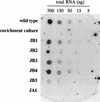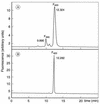Isolation and characterization of Methanobacterium thermoautotrophicum DeltaH mutants unable to grow under hydrogen-deprived conditions
- PMID: 9573152
- PMCID: PMC107219
- DOI: 10.1128/JB.180.10.2676-2681.1998
Isolation and characterization of Methanobacterium thermoautotrophicum DeltaH mutants unable to grow under hydrogen-deprived conditions
Abstract
By using random mutagenesis and enrichment by chemostat culturing, we have developed mutants of Methanobacterium thermoautotrophicum that were unable to grow under hydrogen-deprived conditions. Physiological characterization showed that these mutants had poorer growth rates and growth yields than the wild-type strain. The mRNA levels of several key enzymes were lower than those in the wild-type strain. A fed-batch study showed that the expression levels were related to the hydrogen supply. In one mutant strain, expression of both methyl coenzyme M reductase isoenzyme I and coenzyme F420-dependent 5,10-methylenetetrahydromethanopterin dehydrogenase was impaired. The strain was also unable to form factor F390, lending support to the hypothesis that the factor functions in regulation of methanogenesis in response to changes in the availability of hydrogen.
Figures



Similar articles
-
Cellular levels of factor 390 and methanogenic enzymes during growth of Methanobacterium thermoautotrophicum deltaH.J Bacteriol. 1997 Nov;179(21):6640-8. doi: 10.1128/jb.179.21.6640-6648.1997. J Bacteriol. 1997. PMID: 9352911 Free PMC article.
-
Hydrogen regulation of growth, growth yields, and methane gene transcription in Methanobacterium thermoautotrophicum deltaH.J Bacteriol. 1997 Feb;179(3):889-98. doi: 10.1128/jb.179.3.889-898.1997. J Bacteriol. 1997. PMID: 9006047 Free PMC article.
-
Hydrolysis and reduction of factor 390 by cell extracts of Methanobacterium thermoautotrophicum (strain delta H).J Bacteriol. 1991 Apr;173(7):2283-8. doi: 10.1128/jb.173.7.2283-2288.1991. J Bacteriol. 1991. PMID: 2007552 Free PMC article.
-
Adaptation of methane formation and enzyme contents during growth of Methanobacterium thermoautotrophicum (strain deltaH) in a fed-batch fermentor.Antonie Van Leeuwenhoek. 2000 Apr;77(3):281-91. doi: 10.1023/a:1002443012525. Antonie Van Leeuwenhoek. 2000. PMID: 15188894
-
Purification and properties of coenzyme F390 hydrolase from Methanobacterium thermoautotrophicum (strain Marburg).Eur J Biochem. 1995 Dec 1;234(2):592-7. doi: 10.1111/j.1432-1033.1995.592_b.x. Eur J Biochem. 1995. PMID: 8536708
Cited by
-
Physiology, Biochemistry, and Applications of F420- and Fo-Dependent Redox Reactions.Microbiol Mol Biol Rev. 2016 Apr 27;80(2):451-93. doi: 10.1128/MMBR.00070-15. Print 2016 Jun. Microbiol Mol Biol Rev. 2016. PMID: 27122598 Free PMC article. Review.
-
Metabolic dependencies govern microbial syntrophies during methanogenesis in an anaerobic digestion ecosystem.Microbiome. 2020 Feb 15;8(1):22. doi: 10.1186/s40168-019-0780-9. Microbiome. 2020. PMID: 32061251 Free PMC article.
-
Differential expression of methanogenesis genes of Methanothermobacter thermoautotrophicus (formerly Methanobacterium thermoautotrophicum) in pure culture and in cocultures with fatty acid-oxidizing syntrophs.Appl Environ Microbiol. 2002 Mar;68(3):1173-9. doi: 10.1128/AEM.68.3.1173-1179.2002. Appl Environ Microbiol. 2002. PMID: 11872465 Free PMC article.
-
Mutual Exclusion of Methanobrevibacter Species in the Human Gut Microbiota Facilitates Directed Cultivation of a Candidatus Methanobrevibacter Intestini Representative.Microbiol Spectr. 2022 Aug 31;10(4):e0084922. doi: 10.1128/spectrum.00849-22. Epub 2022 Jun 14. Microbiol Spectr. 2022. PMID: 35699469 Free PMC article.
-
Growth and Break-Up of Methanogenic Granules Suggests Mechanisms for Biofilm and Community Development.Front Microbiol. 2020 Jun 3;11:1126. doi: 10.3389/fmicb.2020.01126. eCollection 2020. Front Microbiol. 2020. PMID: 32582085 Free PMC article.
References
-
- Bonacker L G, Baudner S, Thauer R K. Differential expression of the two methyl-coenzyme M reductases in Methanobacterium thermoautotrophicum as determined immunochemically via isoenzyme specific antisera. Eur J Biochem. 1992;206:87–92. - PubMed
-
- Bult C J, White O, Olsen G J, Zhou L, Fleischmann R D, Sutton G G, Blake J A, FitzGerald L M, Clayton R A, Gocayne J D, Kerlavage A R, Dougherty B A, Tomb J-F, Adams M D, Reich C I, Overbeek R, Kirkness E F, Weinstock K G, Merrick J M, Glodek A, Scott J L, Geoghagen N S M, Weidman J F, Fuhrmann J L, Nguyen D, Utterback T R, Kelley J M, Peterson J D, Sadow P W, Hanna M C, Cotton M D, Roberts K M, Hurst M A, Kaine B P, Borodovsky M, Klenk H-P, Fraser C M, Smith H O, Woese C R, Venter J C. Complete genome sequence of the methanogenic archaeon, Methanococcus jannaschii. Science. 1996;273:1058–1073. - PubMed
-
- Fardeau M-L, Belaich J-P. Energetics of the growth of Methanococcus thermolithotrophicus. Arch Microbiol. 1986;144:381–385.
-
- Gloss L M, Hausinger R P. Methanogen factor 390 formation: species distribution, reversibility and effects of non-oxidative cellular stress. BioFactors. 1988;1:237–240. - PubMed
Publication types
MeSH terms
Substances
LinkOut - more resources
Full Text Sources
Other Literature Sources
Molecular Biology Databases

